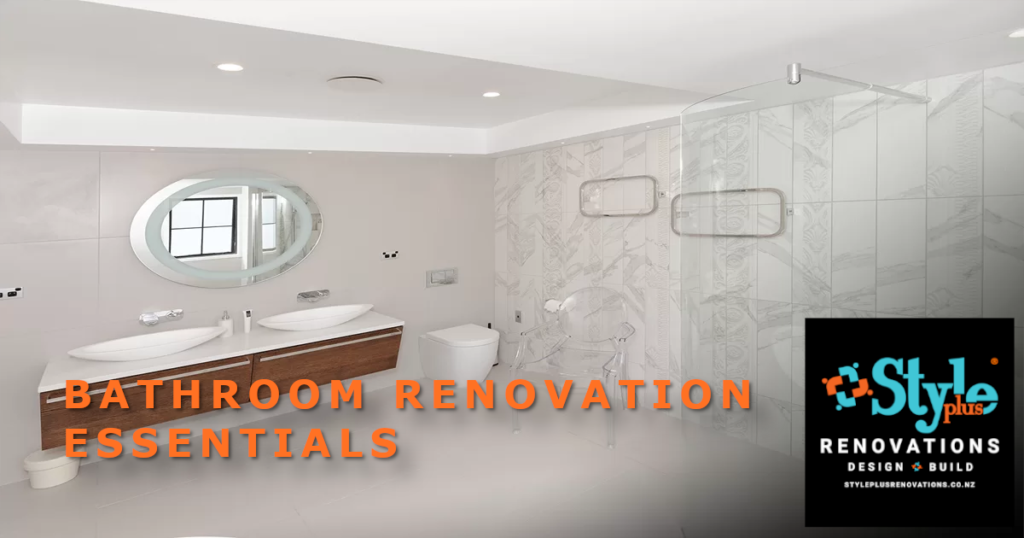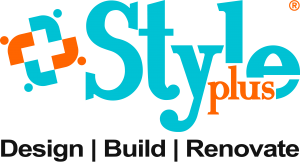WHAT ARE THE BATHROOM RENOVATION ESSENTIALS?
If you are thinking about renovating your bathroom, having a working knowledge of what to expect and what to consider can make a difference. Start by thinking about the bathroom renovation essentials.
– Jan Antoni Glinkowski • Director • Style Plus Renovations
Thinking about renovating your bathroom can be exciting. However, it can also become overwhelming. Any renovation is in no way a simple process.
The team at Style Plus Renovations North Shore Auckland look at some of the design planning essentials for a bathroom renovation:
- Will I require building consent?
- Do I need to waterproof the bathroom floor and walls?
- Which paint do I use for my bathroom renovation?
- Which tiles to choose – ceramic or porcelain?
- Which grout do I use?
- What do I look for when selecting a water-efficient bathroom product?
- What are the options to reduce water consumption for my toilet?
- What are the options for bathroom heating?
- How much contingency do I need?

WILL I REQUIRE A BUILDING CONSENT?
Commonly, there are three questions to be considered when planning a bathroom renovation:
- Will there be any structural changes? Typically, removing a wall between the toilet and connecting bathroom. The question to ask is, is the wall load bearing?
- Are there any changes to the plumbing? If you are re-positioning, or adding any plumbing to alter the layout of a bathroom, you will require a building consent. If you are replacing like for like, such as updated fixtures, in exactly the same positions, then a consent is not required.
- Do I need a building consent for a tiled wet area shower? In all cases, installing a tiled wet area shower will require a building consent.
Style Plus Renovations provide a Full Service Project Management service to help with your building consent.
DO I NEED TO WATERPROOF THE BATHROOM FLOOR AND WALLS?
For bathroom renovations waterproofing applies to the following:
- If you are installing tiles to the floor, the floors must be waterproofed.
- All tiled showers require waterproofing.
- If you’re installing a drop-in bath, waterproofing is required up the walls to at least 300mm.
- If you are installing a freestanding bath, as long as I is at least 100mm away from the wall, waterproofing the walls is not required.
- Waterproofing should be applied 150mm above the basin.
Top Tips:
- A wet area membrane must be applied over all of the area that may be exposed to splashing or water flow.
- If you are looking for a waterproofing and tiling service for your bathroom renovation Style Plus Renovations offers a Waterproofing & Tiling Service.
WHICH PAINT DO I USE FOR MY BATHROOM RENOVATION?
Bathroom paint needs to provide protection from humidity and moisture that leads to staining, chipping and peeling and it is recommended to choose the correct paint product.
Flat/matte finish is commonly used in new construction and on ceilings as it hides flaws. As it does not reflect light directly, imperfections in walls and ceilings are much less noticeable.
Resene SpaceCote Flat is designed to bring enamel style toughness to broadwall areas, allowing you to get a desirable flat finish without sacrificing durability. Very adaptable, it can also be used on interior wet areas and joinery and trims.
Eggshell / low-sheen finishes provide a slight sheen similar in appearance to the surface of an egg. While it is common for use on walls, it is tougher to clean than walls with satin paint, as it tends to absorb stains.
- Resene SpaceCote Low Sheen Kitchen & Bathroom combines the benefits of a waterborne enamel with added anti-bacterial silver protection and MoulDefender is a good option.
Satin sheen provide a slightly more reflective surface and are excellent at resisting mildew, dirt and stains, making them better suited to more frequently used rooms such as bathrooms. They can withstand cleaning and light scrubbing better than flat or eggshell finishes.
Semi-gloss finishes offer high resistance to moisture. High-gloss sheens are reflective finishes that are ideal for highlighting trim and architraves.
- Resene Lustacryl semi-gloss waterborne enamel with added anti-bacterial silver protection and MoulDefender is a good option.
WHICH TILES TO CHOOSE – CERAMIC OR PORCELAIN?
Porcelain or ceramic? Both are part of the larger category of tiles we can call ceramic. Both made from a mixture of clays and other materials, then kiln-fired to approximately 1400 degrees.
Porcelain tiles are generally made by the dust pressed method from porcelain clays which result in a tile that is denser and more durable than ceramic tile.
The finish is a finer grained and smoother with sharply formed faces. Glazed porcelain tiles are much harder and are more wear and damage resistant than ceramic tiles. These types of tiles are suitable for light traffic and heavy traffic.
Porcelain tiles are available in matte, unglazed or a high polished finish. Porcelain tile usually cost approximately 10% more than a ceramic tile.
Ceramic tiles are generally made from red or white clay mixtures. They are finished with a durable glaze which carries the colour and pattern of the finished tile.
They are used in both wall tile and floor tile applications and are softer and easier to cut than porcelain. These non-porcelain ceramic tiles are usually suitable for very light to moderate traffic as they are more prone to wear and chipping than porcelain tiles.
WHICH GROUT DO I USE?
Grout is usually a cement-based material that is used to fill in the spaces between the tiles.
There are basically two types of cement-based grout – sanded and un-sanded:
- Sanded grout is made of Portland cement, sand, and other additives.
- Un-sanded grout, commonly called wall grout, is similar to sanded grout without the sand.
Top Tips
- With these types of grout it is recommended to seal your grout with a silicone sealer to prevent staining.
- In addition to cement based grouts, there are epoxy grouts. This type of grout is made from plastic resins of epoxy, and is mixed with the grout at installation. They are usually more expensive than cement grouts. However, they are more stain resistant.
- Epoxy grouts are difficult to apply and can be quite messy during application.
- Be sure to hire a tiler who is skilled with using and applying epoxy grouts.
WHAT DO I LOOK FOR WHEN SELECTING A WATER EFFICIENT BATHROOM PRODUCT?
New Zealand’s Water Efficiency Labelling Scheme (WELS) is aimed to help home owners make informed choices about the water efficiency of products and encourage water conservation.
The WELS label displays two key pieces of information:
- A water consumption or water flow figure.
WHAT ARE THE OPTIONS TO REDUCE WATER CONSUMPTION FOR MY TOILET?
In an average home, around one litre in five is used for toilet flushing. This can be reduced by:
- Ensuring a dual flush cistern is specified during the planning stage of your renovation or new build.
- Installing a water-efficient toilet pan.
- Using collected rainwater or treated greywater for flushing.
Top Tip:
- Replace the inefficient cistern with a modern dual-flush one that uses either (depending on full or half flush) will use 6 or 3 litres and 4.5 or 3 litres respectively. A new pan may be needed where a dual flush cistern cannot be fitted to the existing one.
WHAT ARE THE OPTIONS FOR BATHROOM HEATING?
Who wants to step out of a hot shower onto a freezing cold tiled floor?
So what are the bathroom heating options?
The first option to consider is installing a heated floor system aka radiant floor heating system. These systems are cleaner, healthier and more responsive than traditional heating appliances.
There are three common types of electric under floor heating systems:
- In-slab heating; in-screed heating
- Under-tile heating / Under floor heating
- Carpet floor heaters.
All of these heating systems involve laying heating wires under the floor and are commonly controlled by a thermostat.
Ceiling mounted bathroom heaters are popular. They are commonly found in an all in one unit that combines the heater, lights and the exhaust fan. They are great for small bathrooms since they do not take up any floor or wall space.
Wall mounted heater, also known as a panel heater are an option. These types of heaters can be installed against the wall. When selecting this type of heater, check the minimum mounting distances against the design of your bathroom.
For example a WEISS FH30SS requires the location of the heater to have the minimum mounting distances:
- At least 1800mm from the floor up to the heater
- At least 200mm from the heater to the ceiling
- At least 250mm from any adjacent walls
- At least 700mm from the heater to any objects
HAVE A CONTINGENCY FUND FOR YOUR BATHROOM RENOVATION
When renovating a home there are a number of things that can go wrong. Be prepared with a contingency fund and make sure to use it only in cases of readjustment due to unforeseen events or issues that require a costly solution.
The amount allocated to contingency in a budget depends on the nature and complexity of the project, but it is usually somewhere between 10% and 20%.
Check out the bathroom renovations costs calculator if you are looking for an indicative bathroom renovation estimate. Also if you are looking at renovating your bathroom into a lux spa room, check out our spa room design options article.
Want to ensure your bathroom renovation goes smoothly? Talk to the experts at Style Plus Renovations now.
Get started with a Free
Architects Renovation Feasibility Report
LET'S START
YOUR RENOVATION PROJECT
Tel us about your renovation project and we’ll call you back for a no-obligation chat about your ideas.
Alternatively, if you prefer, we can initially set up a meeting using Microsoft Teams or Zoom (and other meeting apps) for a no-obligation chat about your ideas.
We look forward to hearing from you to discuss your project and get you started on your renovation journey.
If you would like to know more about our renovation process, check it out here.

